MAJOR SOIL RELATED CONSTRAINTS IN KERALA
LATERITES AND LATERIZATION
Kerala has a unique place in the field of pedology. Buchanan (1807) first reported the presence of ferruginous
vesicular material occurring within the soils from Angadipuram in Malappuram District. The material was found to be irreversibly hard on
exposure to air and was widely used for construction purposes. The word laterite was coined from the Latin word later meaning brick.
Laterite and laterization process widely occur in Kerala, the occurrence of red and laterite associated soils distributed over 70 per cent
of the geographical area is ample evidence of the conducive factors of soil formation and pedogenic process occurring in the state.
The intense leaching of bases and desilication followed by residual accumulation of iron and aluminium oxides are key process.
The undulating terrain in the state especially in the midland region coupled with the high rainfall conditions have accelerated soils
erosion to alarming proportions in areas devoid of soil cover. The removal of the surface soil exposes the laterite pan which on consequent
drying and dehydration leads to irreversible hardening. The hardened laterite form is often termed petro plintite or duricrust. Extensive areas
of such eroded lands are common in the laterite landscape in the northern district of the state and are a grim reminder of the mismanagement
of soils.
The gravel content in laterite soils of Kerala ranges from 15 to 70 per cent. The gravelliness factor depending
on the soil texture increases the bulk density which adversely affects the foraging capacity of plant roots for nutrients. The decrease
in soil volume also leads to poor inherent soil fertility, lesser available water capacity and other hydrological properties. The low water
holding capacity of the low activity clays also brings about water stress in the root zone during summer months. This is especially severe in
the northern districts of the state.

SOIL RELATED CONSTRAINTS
The state is located in the humid tropical belt characterized by high rain fall and temperature conditions. The distinct altitudinal variations and undulating topography has a modifying effect on the various factors of the soil formation. Different combinations of the soil forming factors have resulted in the development of a variety of soils and soil related constrains which have a direct bearing on crop production. The major soil related constraints from the point of view of soil health are:
Physical
- Steep slopes and erosion
- Root zone limitation
- Gravel content and hard pans
- Poor drainage and hydrology
- Drought stress
Chemical
- Soil acidity
- Acid sulphate soils
- Aluminium and iron toxicity
- Subsoil acidity
- Low nutrient reserves and retention
- High phosphorus fixation
- Secondary and micro nutrient status
- Soil salinity through sea water intrusion
- Biological
PHYSICAL
STEEP SLOPES AND EROSION
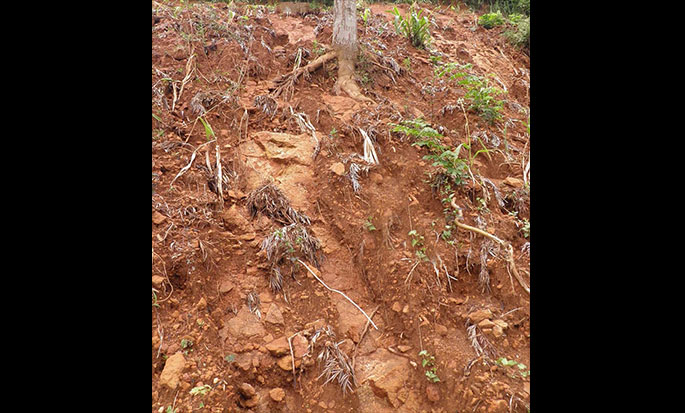
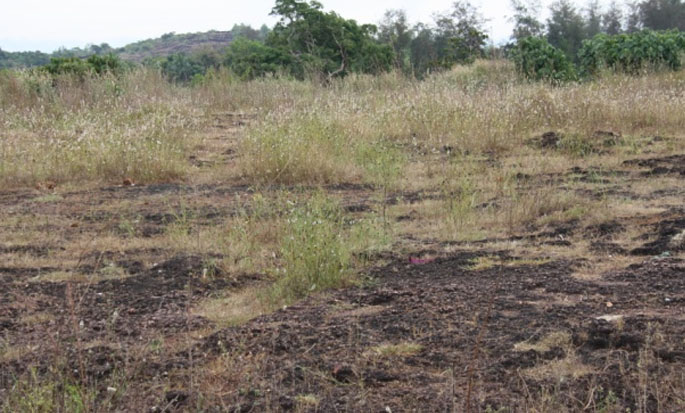
The major part of the State is hilly and undulating topography with wide range of slope classes.
The high precipitation and undulating topography especially in the mid land laterite region with high erodibility has accelerated
water erosion with substantial losses of top soil and available nutrients.
In the laterite terrain exposure of the laterite bed by erosion and its prolonged drying and dehydration causes the formation
of stone/petro plinthite. Extensive areas of these formations are the characteristics landscape features in Kozhikode, Malappuram,
Kannur and Kasaragod districts of Kerala.
ROOT ZONE LIMITATION
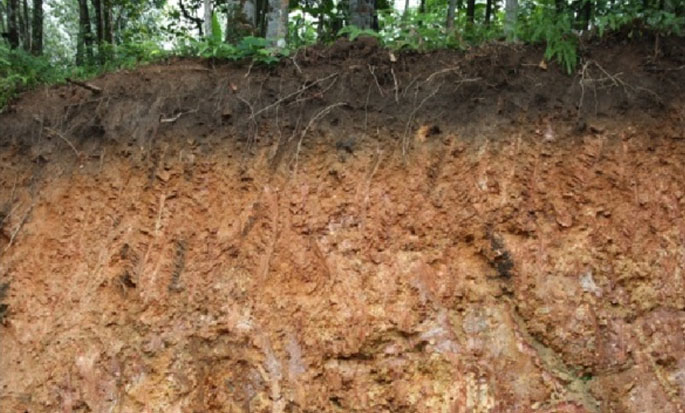
This is the outcome of severe water erosion causing removal of surface soils and exposure of the laterite beds.
The laterite pan is soft when under a column of soil, but hardens on exposure causing plant root penetration and workability, difficult.
Dehydration of plinthite brings out an increase in bulk density making root penetration difficult.
GRAVEL CONTENT AND HARD PANS
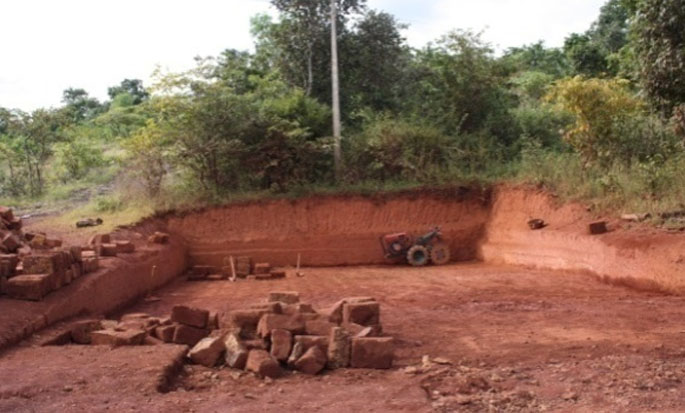
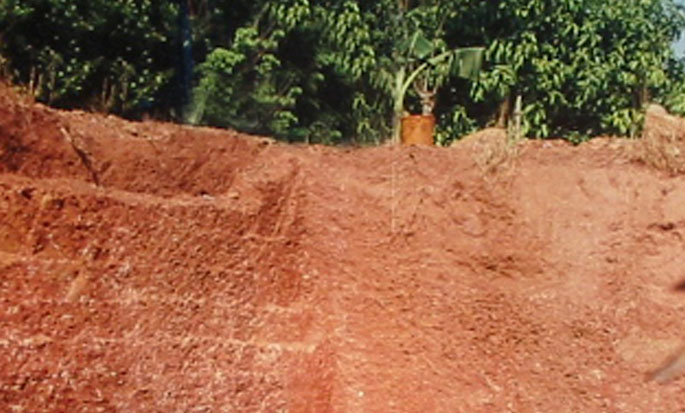
The gravel content in laterite soils of Kerala ranges from 15 to 70 per cent. The gravelliness factor depending
on the soil texture increases the bulk density which adversely affects the foraging capacity of plant roots for nutrients. The decrease
in soil volume also leads to poor inherent soil fertility, lesser available water capacity and other hydrological properties. The low water
holding capacity of the low activity clays also brings about water stress in the root zone during summer months. This is especially severe in
the northern districts of the state.
POOR DRAINAGE AND HYDROLOGY
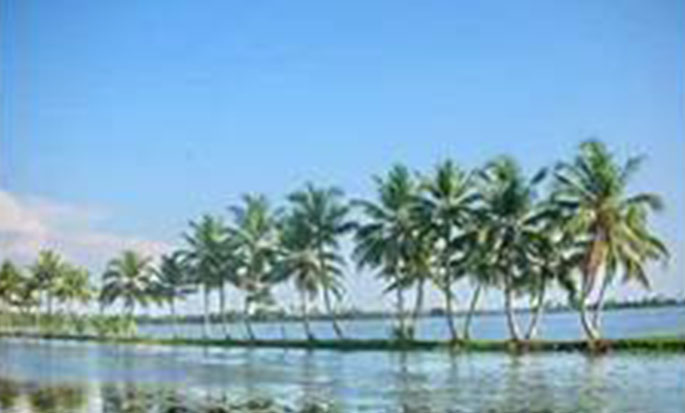
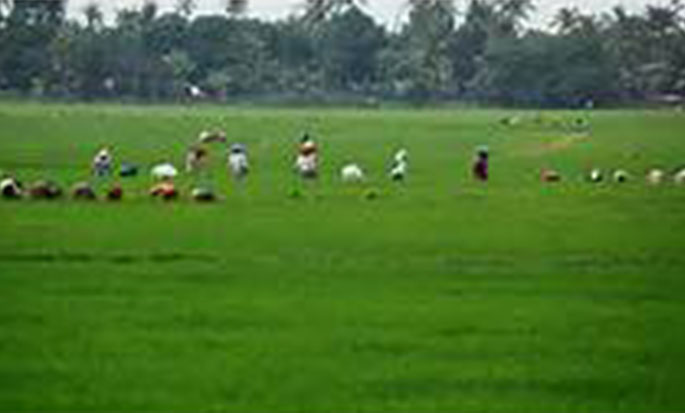
Majority of the soils of the state are well drained and they do not pose serious crop management problems. The coastal alluvial soils are excessively drained and needs careful water management strategies for crop production. Poor drainage conditions are consequent on high water erosion and water logging in the lower landscape positions resulting in flooding. Water logging is a characteristic feature of the Kuttanad, Kole, Pokkali and Kaippad lands which have topographic disadvantage of lying below sea level.
DROUGHT STRESS
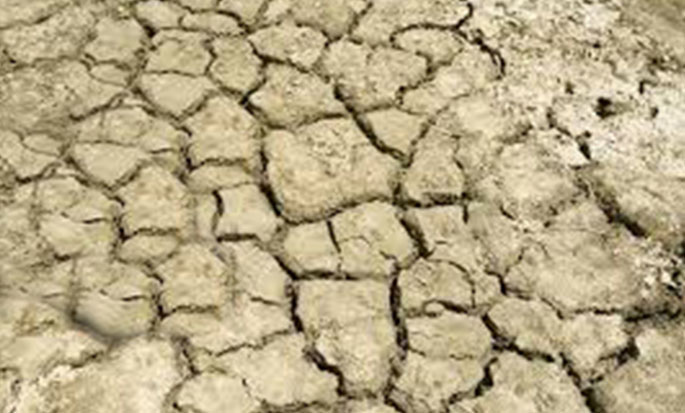

The low available water capacity as a result of gravelliness of the laterite soils, presence of laterite pans and consequent reduced soil volume has been responsible for intense moisture stress in the root zone leading to drought. The erratic monsoon rains also contribute to severe drought stress in the state
CHEMICAL
SOIL ACIDITY
The soils of the state have developed from acidic parent rocks under the humid tropical environment, characterised by high rainfall and temperature conditions which are conducive to rapid removal of bases from the soil. More than 90 per cent of soils in Kerala have acid reaction. As much as 54 per cent of soils are extremely to strongly acidic (pH 3.5 to 5.5) requiring amelioration with lime to alleviate acidity.
ACID SULPHATE SOILS
Waterlogged problem areas of Kuttanad, Kole, Pokkali and Kaipad lands have ultra acid soils with pH less than 3.5. These soils are developed mainly from sulphur rich sediments of marine origin and in some areas occur below sea level and are illdrained. Oxidation of these sediments under aerobic situation experienced during summer months causes extreme acidic conditions leading to the formation of acid sulphate soils. These soils also require acidity amelioration through regular liming and special management methods.
ALUMINIUM AND IRON TOXICITY
Majority of the soils of the state are rich in iron and aluminium oxides and strongly acid with pH less than 5.5
resulting in high levels of soluble Al which accumulates in the root tip and causes injury and inhibits root growth. Aluminium toxicity
occurs in the potential acid sulphate soils of Kuttanad, Kole, Pokkali and Kaipad lands. Under aerobic conditions, pyrities mineral get
oxidized to jarosite which is hydrolyzed to iron hydroxide and sulphuric acid causing drastic reduction in pH values. In the laterite region,
the sub soil layers of the profile with pH less than 5.5, the clay minerals are solubilized bringing into solution K, Mg, Fe and Al.
Concentration of Fe and Al increases to toxic levels in soils.
Iron toxicity is often encountered in flooded anaerobic situation especially in rice ecosystem. The reducing conditions bring about
solubilisation of oxides of iron, which compete with other cations like K+, Ca2+, Mg2+ and Zn2+, leading to deficiency of these elements.
High concentration of soluble Fe also causes precipitation of soluble P into insoluble forms making it unavailable to plants. Toxic levels
of Fe are also harmful to the roots. Iron toxicity is more observed under poorly drained conditions and in soils with low cation exchange
capacity.
SUBSOIL ACIDITY
The subsoil layers of the laterite soil are often very strongly acid (pH 4.5 and less) resulting in solubilisation of exchangeable Al and deficiency of Ca and Mg. Exchangeable Al in toxic levels inhibits root growth and the target is the root apex causing stunting of primary roots and growth inhibition of the lateral roots. Combined application of gypsum (CaSO4•2H2O) and dolomitic limestone is recommended to neutralize exchangeable Al levels in subsoil and alleviate deficiency of Ca and Mg. Gypsum and its combination with liming materials enables substantial movement of Ca and Mg to lower levels due to the presence of stable and mobile SO42- ion. Gypsum (phosphogypsum), a byproduct from fertilizer industry is available in the state.
LOW NUTRIENT RESERVES AND RETENTION
In general, the soils of the state are highly weathered and dominated by low activity clays with acidic pH, very
low cation exchange capacity (CEC) and base saturation, low nutrient reserves and low water holding capacity. The high rainfall conditions
result in intense leaching leading to further decrease in nutrient status. The dominance of low activity clays with low CEC and poor carbon
reserves contribute to poor nutrient retention in soils.
Low organic matter content of the soil is another factor responsible for the poor nutrient and water holding capacity of soils.
Rregular application of organic manures and green manuring helps in improving carbon reserve and thereby improving nutrient and water
holding capacity
PHOSPHORUS FIXATION
The important factor controlling the availability of P in soils is the maintenance of soil pH between 6.0 and 7.0. Soils of the state are acidic and rich in sesqi-oxides with resultant P fixation to the tune of 90 -95 %. Around 64 per cent of the cultivated soils of Kerala are high in available phosphorus. This is indicative of the high doses of applied P fertilizers which get fixed initially in the colloidal fraction of the soil and subsequently getting solubilised resulting in high P levels in soils.
SECONDARY AND MICRO NUTRIENT STATUS
Extensive deficiencies of secondary nutrients (Ca and Mg) and micro nutrient (boron) have been observed in Kerala soils. Application of liming materials such as dolomite, calcium carbonate and magnesium sulphate are recommended for alleviating deficiency of Ca and Mg. Application of copper sulphate, zinc sulphate and borax is recommended for correcting deficiencies as per the recommendations of Kerala Agricultural University.
SOIL SALINITY THROUGH SEA WATER INTRUSION
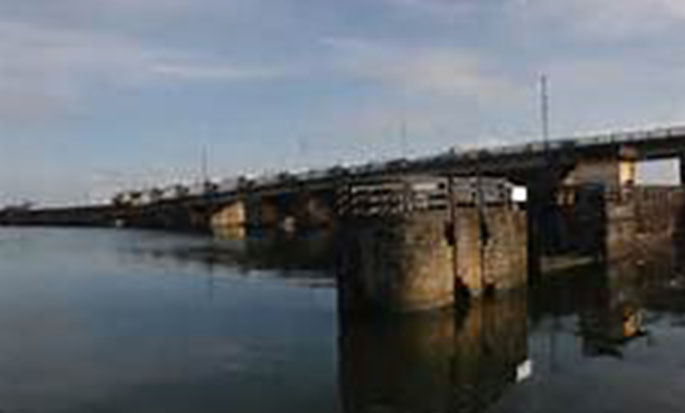
Salinity of soils is mainly a problem in the rice ecosystem in areas adjacent to the coast through sea water ingress.
The problem is only seasonal and aggravates during summer months at high tidal flow. The monsoon rain often washes out the accumulated salts
leading to low salinity levels enabling cultivation of rice. Rice is being cultivated in Kuttanad region where saline intrusion is protected
through construction of bunds and barrages.
Cultivation of salinity resistant rice varieties is common in these areas. However, no protection
has been provided in the Pokkali and Kaipad Lands against sea water intrusion and rice cultivation is carried out after the monsoon season
when salinity levels are low due to washing out of salts.
BIOLOGICAL
The soil micro flora utilizes organic matter as source of energy and high levels of organic matter are often conducive
to intense biological activities. The high temperature and destruction of vegetative cover has accelerated the oxidative process due to exposure
leading to depletion of the organic carbon stock. Recycling of organic matter in crop lands are not sufficient to compensate for the oxidative
losses.
Soils of Kerala being strongly acidic, alleviation of soil acidity through liming has to be a regular practice for sustaining the soil
biological balance. Maintenance of soil organic matter at satisfactory level is also an equally important management requirement for
sustaining the biological bio diversity of the soil.
Contact Us
+ 91 471 2527567, + 91 471 2700777

© 2019 | System conceived,designed and implemented by IIITMK


